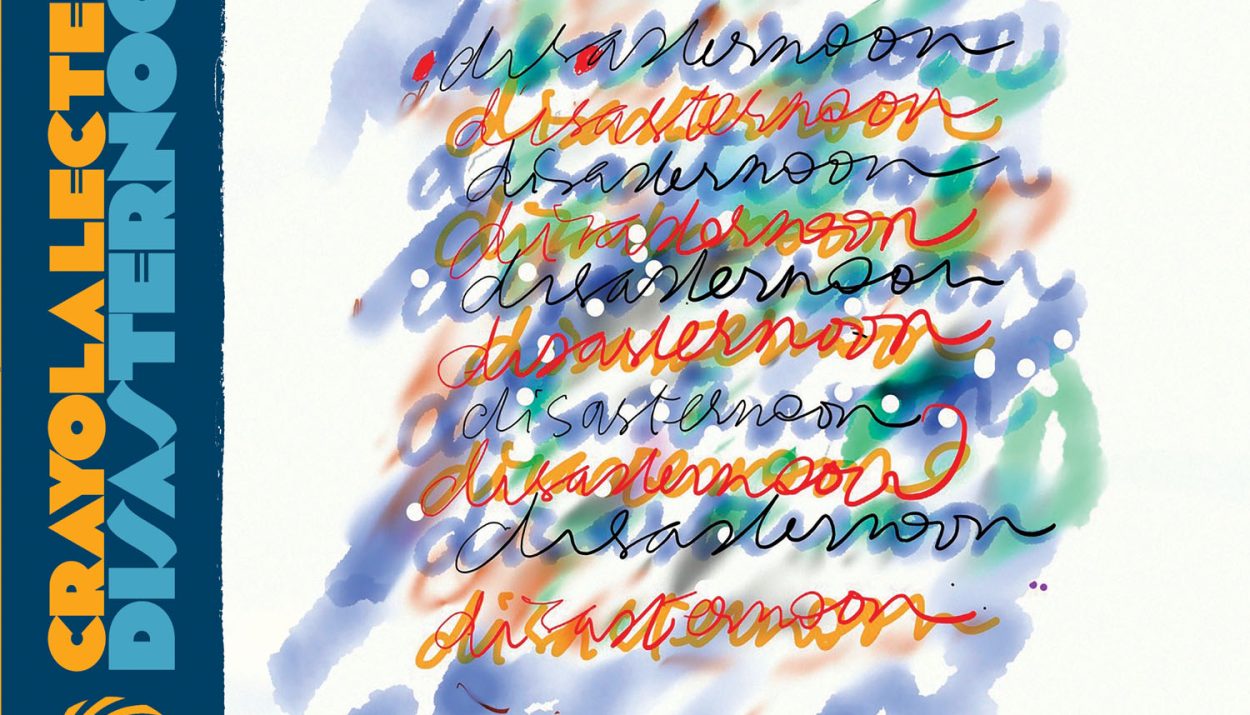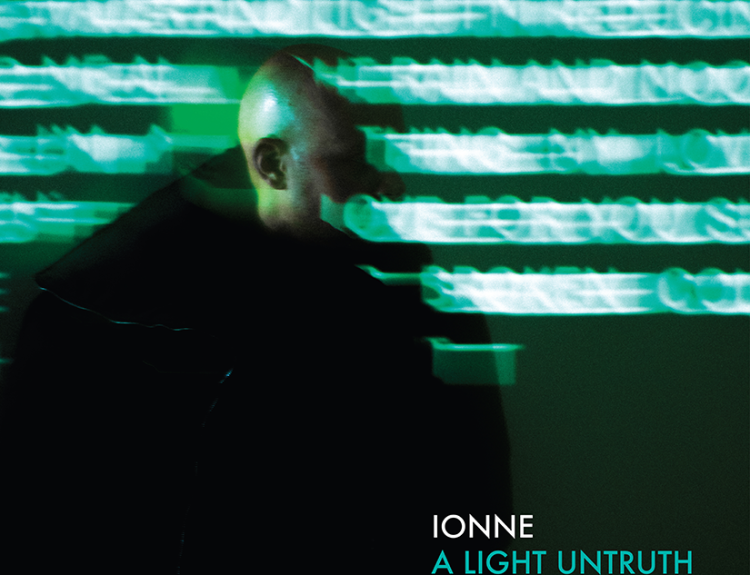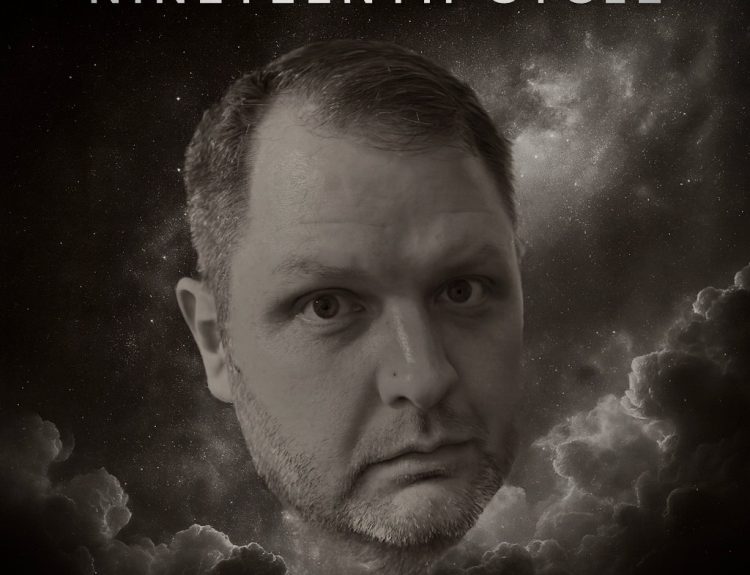There’s a certain magic that happens when Crayola Lectern set their instruments loose. The Worthing-based trio; Chris Anderson, Damo Waters, and Alistair Strachan have long been masters of turning pastoral psychedelia into something intimate yet vast, whimsical yet heavy with emotion. With “Disasternoon,” their third studio album, they take that art to its most ambitious heights yet, creating a collection of tracks that feel like cinematic postcards from alternate realities, each one brimming with wonder and a wry melancholy.
Recorded at Ghosty Mill Studio in Worthing and mastered at Golden HIVE in Prague, the record benefits from Anderson’s production and mixing wizardry, with additional touches on the title track by Bic Hayes and Waters. The sonic tapestry here is exquisite: mellotrons breathe like ghosts, cornets rise like sunlight breaking through storm clouds, theremins hum with alien charm, and pianos carry the weight of unspoken thoughts. Every note feels deliberately placed, every sound given the room to bloom, creating a listening experience that is as rich as it is surreal. Let’s explore the album track by track.
From the first notes, the album sets itself apart as an immersive, lived-in experience. Opener “Sad Cornetto” doesn’t rush to make its point; instead, it wakes like a soft morning light creeping through the curtains. Glockenspiel sparkles over deliberate percussion, while Anderson’s warm, earnest, and lightly textured vocals deliver lines that capture the album’s overarching spirit. His delivery is intimate but unafraid to reach upward, inviting us into a shared moment of quiet reflection before the journey deepens.
“Aparty Days” glows with a bittersweet optimism. Strachan’s cornetto work here feels almost like an additional vocalist, answering the piano’s playful yet slightly sorrow-tinged phrases. There’s a buoyancy to the rhythm, but it’s laced with nostalgia—like a celebration held under overcast skies. The performance blends restraint and warmth, a gentle nudge forward without losing the wistful haze that lingers.
Then comes the title track, “Disasternoon,” epic in scope and ambition. This is where the trio take flight, throwing open the sonic gates to a cosmic escape. The production layers theremin swells, lush pianos, and bold percussion into something that feels at once kaleidoscopic and deeply human. Anderson’s voice stretches into theatrical territory, weaving between whispered tenderness and unshackled exclamation. The lyrics are like postcards from a dream, charged with liberation and loss.
“Stars Over Louth” offers a necessary pause. Here, mellotron and Rhodes drift like low clouds, with muted trumpet lines punctuating the stillness. This is minimalism with purpose; each note feels weighed and intentional, creating a less a song and more a slow-unfolding painting soundscape. The trio’s chemistry is palpable; every instrument breathes in sync, allowing the atmosphere to become the track’s true protagonist.
“The Sky Over The Sea” plunges fully into the otherworldly. Seabird calls flutter through the mix, evoking a strange, dreamlike shoreline. There’s a sense of improvisation at play here, a willingness to let the song wander into uncharted waters. The fluidity of the instrumentation; a drift of Rhodes, distant percussion, underwater-like bass resonance, makes this track feel like a lucid dream where the edges blur and logic fades away.
One of the album’s most personal moments, “Dissolve”, tells the story of Angelito, a character losing himself to mental struggle. The arrangement mirrors this emotional erosion, textures thin out, piano motifs fragment, and brass tones seem to melt into the background. Anderson’s delivery is fragile yet piercing, letting you feel the vulnerability in every syllable. This song is a stark reminder of how delicately beauty and despair can coexist.
“Oblivion” moves inward again, this time in search of a kind of mental surrender. The repeated descent of the trumpet’s heavy notes feels like falling but not without comfort. The lines are delivered in a hush, almost conspiratorial, drawing you into an intimate confidence. The performance here is one of restraint, a masterclass in saying more with less.
Closing with “Coscoroba”, the trio lean into their experimental impulses. It begins with stately piano and violin, steeped in psychedelic melancholia, before dissolving into a krautrock-inspired jam that feels bold, expansive, and quietly majestic. The shifts in tempo and texture feel like watching a flock of birds change direction mid-flight—sudden yet graceful.
From start to finish, “Disasternoon” thrives on contrasts: lush yet spacious, structured yet spontaneous, melancholic yet wry. Anderson’s production brings every detail into focus without over-polishing—allowing the slight imperfections and human touches to become part of the album’s charm. The interplay of instruments is masterful: the cornet and trumpet lines often serve as emotional counterpoints, the mellotron and Rhodes set painterly backdrops, and the percussion subtly pushes the narrative forward without ever demanding attention.
Crayola Lectern have crafted a record that doesn’t just play—it stays and seeping into your subconscious long after the final notes fade. This is more than an album; it’s an invitation into a parallel world where beauty blooms in unexpected places, and even the darkest corners shimmer if you look closely enough. It isn’t just a return for Crayola Lectern; it’s a reintroduction worthy of a standing ovation. They arrive not with a shout, but with a steady, mesmerizing gaze, holding out their latest creation like a rare object they’ve polished in secret. And in Disasternoon, they’ve given us something rare indeed: a psychedelic dream you won’t want to wake from.
Listen to the ‘Disasternoon’ album on Spotify
Follow Crayola Lectern here for more information






